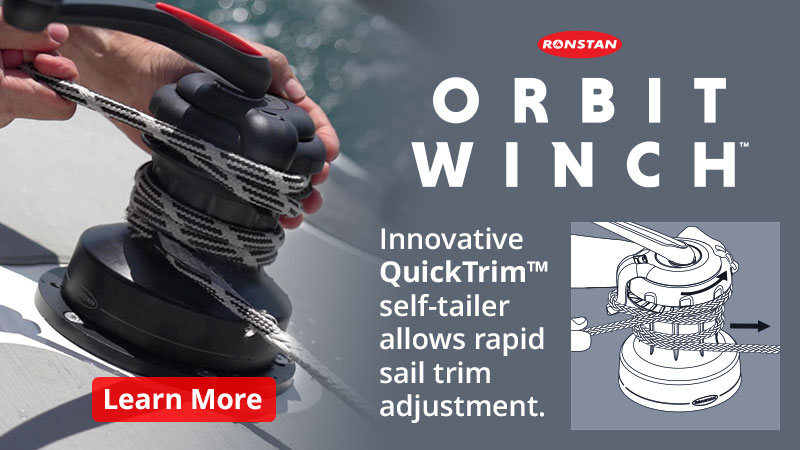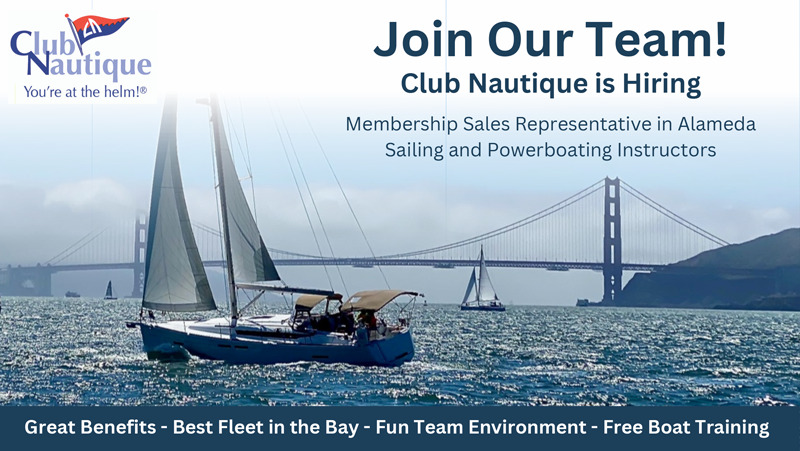
Mike Martin and Adam Lowry Win 5O5 Pre-Worlds
The 5O5 Pre-Worlds, held this past weekend, were just a warm-up for the big show: the 5O5 Worlds, which start tomorrow on San Francisco Bay. But that doesn’t mean that the preceding regatta was any less competitive. At stake was the new Howard Hamlin Perpetual Trophy, as well as the North American Championship trophy. The St. Francis YC race team ran six races over this past weekend for the Pre-World regatta to get the teams warmed up for the big show.
At the end of the Pre-Worlds it looks like the 2019 Worlds, with Mike Martin and Adam Lowry being the team to beat.
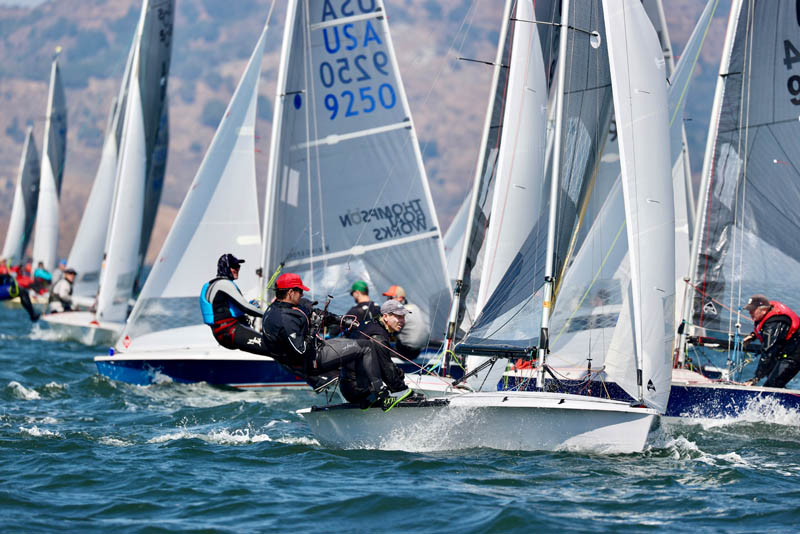
On Saturday, the 5O5s raced west of Alcatraz Island, with Martin and Lowry leading the pack of 60 teams with a 2-2-1 score line. Racing was very tight, with boats up and down the fleet gravitating toward each other at the marks. The leading duo favored the south side of the course for most of the day.
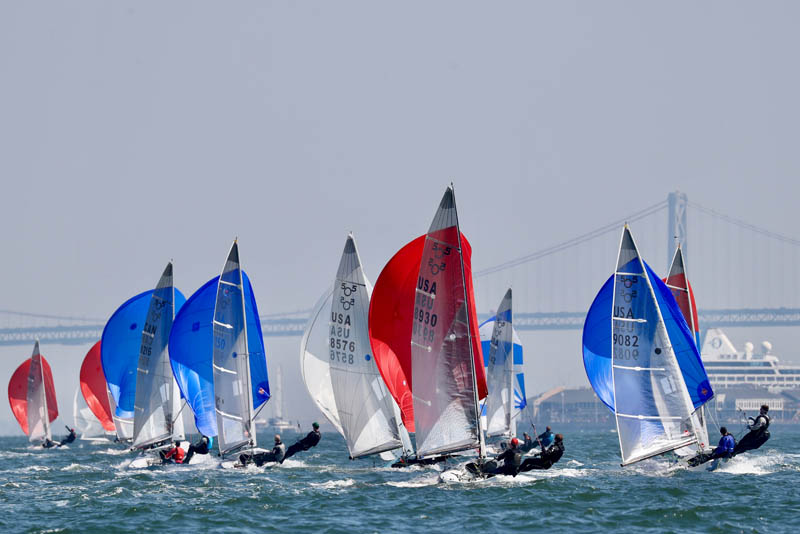
On Sunday, the 5O5s sailed west of Treasure Island with a mild crosscurrent and more champagne conditions for San Francisco Bay. Three races were completed on windward-leeward courses, with the final race finishing to windward to help the sailors return to the harbor at St. Francis Yacht Club.
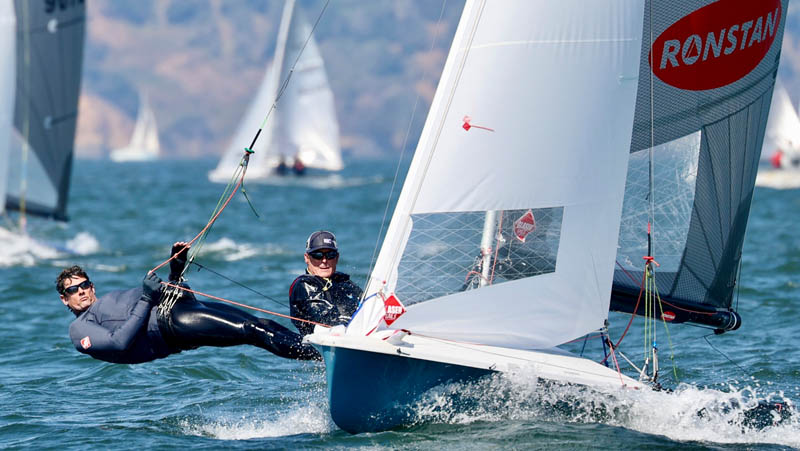
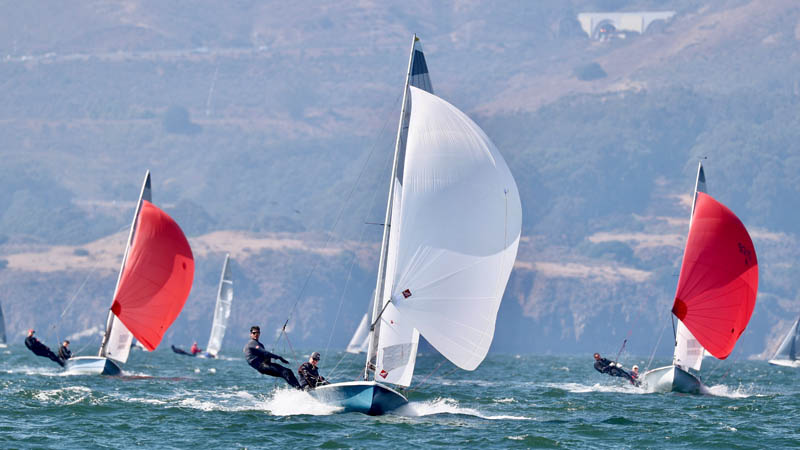
Martin and Lowry continued their lead, finishing first and winning both of the aforementioned trophies. Nic Baird and Eric Anderson scored two bullets on the final day, but it wasn’t enough to overcome Martin and Lowry’s lead. Third place for the Pre-Worlds went to the British team of Nathan Batchelor and Sam Pascoe, and the third-place North American team was Howard Hamlin and Jeff Nelson.
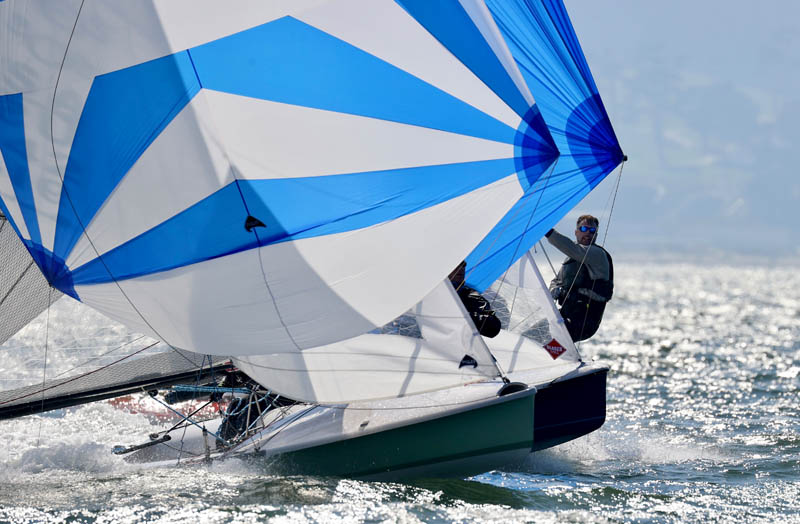
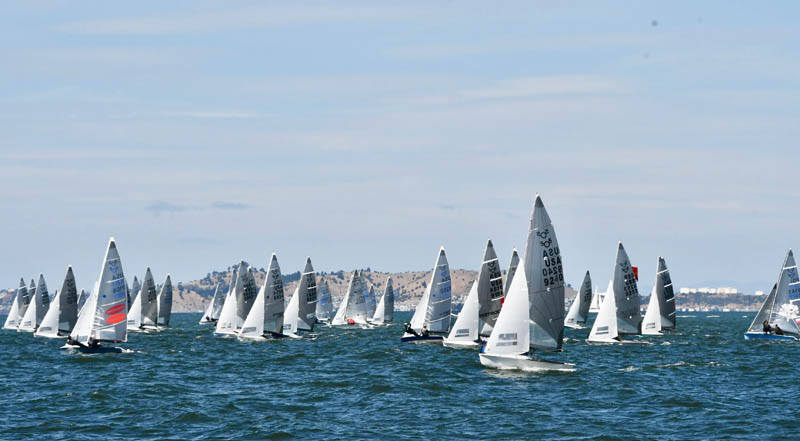
The 5O5 Pre-Worlds and Worlds have drawn a diverse field of competitive teams from the United States, Australia, Canada, France, Germany, Great Britain, Ireland and Poland, including several past world champions: Howard Hamlin (1999) and Jeff Nelson (2009); Mike Holt (2014, 2015, 2017) and Carl Smit (2015, 2017); Mike Martin (1999, 2009, 2016, 2019) and Adam Lowry (2016, 2019); and Ian Pinnell (2008). California has long held a very strong position in the class, with Morgan Larson and Trevor Baylis also being world champions in 2004, racing as team Waterat. Larry Tuttle, who finished sixth in the 1981 Worlds (shown below), is owner of Waterat in Santa Cruz, the go-to shop for fast foils in 5O5 racing.
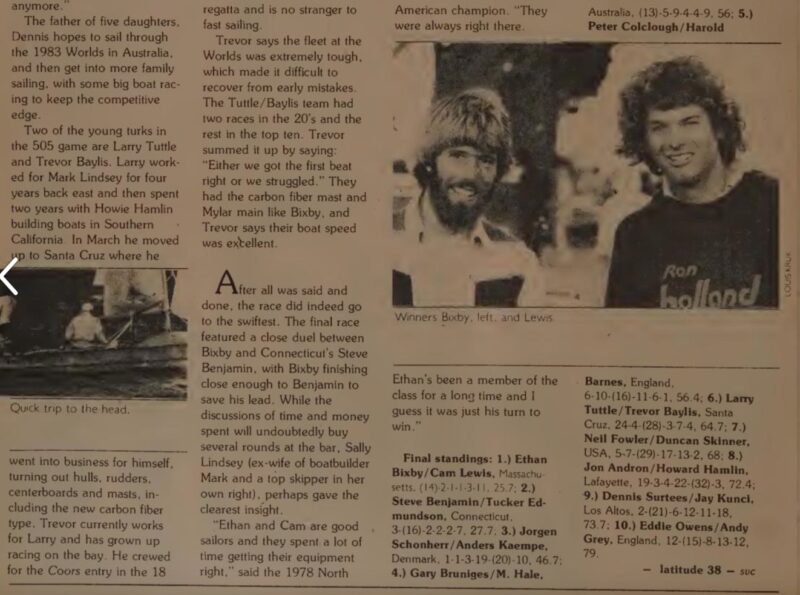
On Sunday evening, trophies were awarded at St. Francis Yacht Club, and race organizers officially opened the 5O5 World Championships. Racing begins on Tuesday, September 26, with first warning at 12 p.m. Pacific Daylight Time. The 5O5 Worlds will run from September 26 through October 1, with five days of racing and one lay day.
You can see complete results and information here.
Who’s Heading South in the Baja Ha-Ha?
It’s that time of year again when we get to know a few of the sailors signed up for this year’s Baja Ha-Ha. Here are a few of the faces sailing with the class of 2023.
Ale er Ron — Hunter 460
Ron Johnston and Holly Hall
San Diego
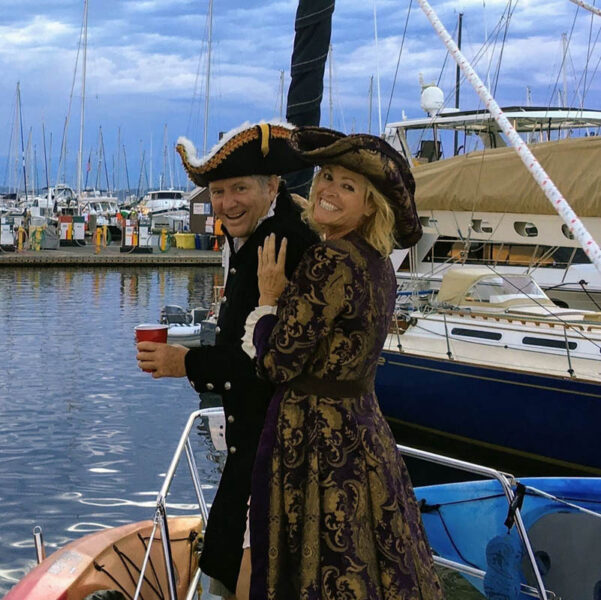
Ron, 67, is a retired test pilot for Boeing. Holly is retired from an unspecified career. Their crew will be friends Emily Pruitt and Tyler Wilson.
“Captain Ron” started sailing at age 17 while in high school in Guam. He has owned and sailed several boats. Ron bought Ale er Ron — the name a play on an important aircraft component and his name — in 2005, and it’s been his “love and joy” ever since.
Captain Ron, whose nickname has also been “Taco” for 40 years, lived aboard in Seattle until retiring from Boeing in 2017. During the 12 years living in Seattle, he got off the dock nearly every week, summer and winter, to explore Puget Sound or participate in a regatta. Taco is proud to say that he is the one primarily in charge of his boat’s maintenance, and only rarely needs to bring in a mechanic.
The day after retiring, Ron started cruising by heading up the Inside Passage to Alaska with numerous stops in British Columbia. Intending to stay in Alaska for only that summer, he and his first mate fell in love with it, and ended up spending four summers there. Ale er Ron shared numerous beautiful small anchorages with friends and family. The usual segment was a 10-day adventure, leaving one port that had airline service and dropping the friends off at a different port with airline service.
During the four summers in Alaska, the USCG boarded Ale er Ron three times. Each time the vessel, crew, and captain received the “gold-standard” of inspections, with a perfect inspection report.
After four wonderful summers in Alaska, Captain Ron and his first mate Holly have decided to try cruising in warmer and drier climates. After a winter haulout in Anacortes, where numerous maintenance tasks were completed, Captain Ron headed down the West Coast and is currently in San Diego.
His overnight offshore experience includes a one-night voyage from Astoria to Neah Bay, where he and his crew of three weathered 25 to 35 knots of wind and 10-foot seas at 11-second intervals. The boat and crew came through fine. This past summer, Captain Ron and a crew of four made a two-night passage from Coos Bay to San Francisco Bay, including rounding Cape Mendocino in seven-foot following seas. Three of those four crew members will be on the Ha-Ha; one of them is an instructor for his local sailing club in Seattle.
Amizade — Bavaria 47
Mike and Jennifer Ward
Port Townsend, Washington / Tonasket, Washington
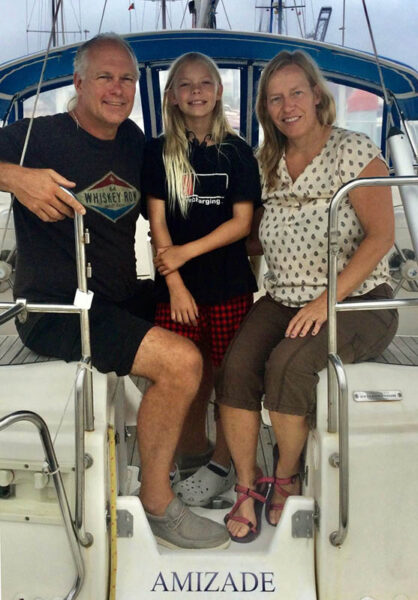
Michael Brian, 56, is a fisheries ecologist, while spouse Jennifer is an educator. Their crew will be Leia “Wren” Ward, 10, a student of life.
“The motivation for our current cruising adventure comes from a conversation on a dock in Auckland’s Westhaven Marina in 2010 at the end of our last Pacific crossing. I was telling a Kiwi sailor, “The best thing I’ve ever done is go cruising on a bluewater sailboat.”
“That’s the second-best thing I’ve ever done,” responded the father of a couple of grown kids. “The best thing is cruising with kids. You should try it!”
“Since then Jennifer and I endeavored to do just that, by getting married, starting a family, and working hard to find and buy our next boat. Finally, here we are, ready to start an epic kid-cruise. Naturally, we are very keen to meet and buddy-boat with the other kid boats in the fleet.”
Mike has been sailing his whole life, and Jennifer has been sailing since she prepared to join Mike in Tahiti on his previous boat, the Kelly-Peterson 44 Thin Wolf at the end of the 2009 Pacific Puddle Jump. Jennifer then cruised the next 5,000 miles from Papeete to Auckland with Mike. Wren is being raised as a boat kid by sailing, whitewater rafting, and canoeing ever since she was a toddler.
“We purchased our 2000 Bavaria 47 Amizade in Puerto Vallarta in January 2023,” reports Mike, “then sailed her uphill in preparation for the 2023 Ha-Ha. Alas, relentless conditions north of Point Conception turned us back. Unable to find a suitable slip in Southern California, we berthed in Ensenada for the summer.
“In addition to Amizade, we previously co-owned the Kelly-Peterson Thin Wolf with acclaimed artist Luke Tornatzky. We sailed her in the 2008 Baja Ha-Ha and the 2009 Pacific Puddle Jump. Mike’s most recent rally was doublehanding in the Salish 100 in 2022 with a Com Pac-16. [We have] also explored the San Juan Islands on charter boats, and try to take an annual multi-day whitewater rafting trip on one of the rivers in the Pacific Northwest.”
Mike’s longest passage was 3000.0 miles — literally to the tenth of a mile! — from Puerto Vallarta to Hiva Oa in 2009. Jennifer once did a 1,500-mile passage from Tonga’s Ha’apai Islands to the Bay of Islands in New Zealand — but that doesn’t count her thousands of miles at sea on fishing boats in Bristol Bay and the Gulf of Alaska. Wren’s longest passage so far has been across the Strait of Georgia from Salt Spring Island to Vancouver, although she’s planning to cruise out to the Island of the Blue Dolphins next month.
“After the Ha-Ha, we plan to cruise Mexico until spring 2024. If all goes well, we’ll follow our dream of crossing the Pacific as a ‘kid boat.’ Otherwise, we’ll either gunkhole back to the Southern California bight or sail to Puget Sound via Hawaii.”
Jen is a lefty. Both Jen and Mike are meditators. Wren’s favorite dessert is helados de yogurt, which she recently discovered in Ensenada.
Annie’s Song — Catalina/Morgan 440
Will and Emily Blake
Channel Islands / Flat Rock, North Carolina
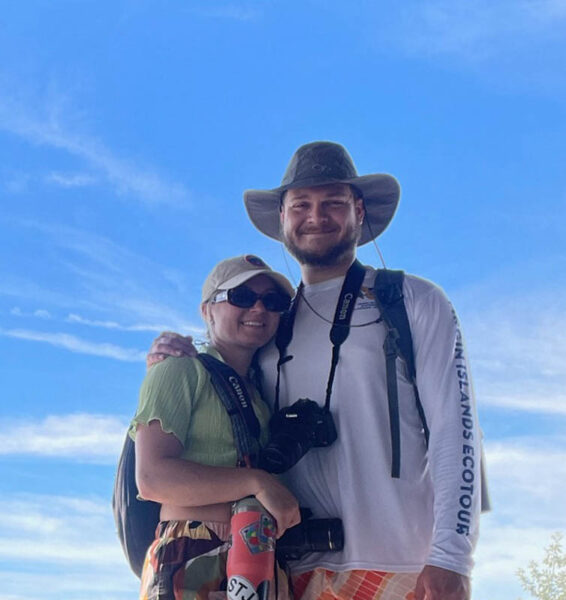
Will, 28, is in the software field. Emily is — get this — a pipefitter. The Poobah salutes women in the trades. William and Emily will doublehand.
“We have been sailing together, always with our four-legged companion Ludog, for the past 12 years,” they say. “So far our sailing has been on the East Coast, in the Caribbean, and on the Great Lakes, so we’re eager to see what the West Coast has to offer. The bonfire story we like to tell is when we had no option but to go the wrong way through a force-8 gale in the Exumas during the off-season. What a ride that was!
“Early this summer we purchased the most recent of the three boats we’ve owned, the spacious Catalina/Morgan 440. We are very proud of her. We have not done a Ha-Ha before and are signing up after many personal recommendations. After the Ha-Ha, we plan to explore the Sea of Cortez for the remainder of the fair-weather season. After that, who knows?
“Our dream is to circumnavigate, and the more we are looking into all the potential destinations the harder it is to say which one represents the most dreamlike. French Polynesia is a likely candidate.
“Our dream boat is the Sirius 40 DS with the lifting keel, but in all honesty, we think our 440 is right up there. Skip Novak, who did four Whitbread Around the World Races and for the last 20 years has been doing charters in Antarctica, is our sailing hero, the fictional Martin Harvey being the second.
“A nicely made tiramisu is our favorite dessert. Both of us are right-handed and neither have fun nicknames, but we have an infinite number for our dog.
“We are really looking forward to the Ha-Ha!”
We’ll have more Ha-Ha profiles in Wednesday’s ‘Lectronic Latitude.
Discover Ronstan Orbit Winch
The Resourceful Sailor Revives an Apelco Ranger 360 Echo Sounder
Sampaguita, a 1985 Pacific Seacraft Flicka 20 sailboat, came with an Apelco Ranger 360 Echo Sounder when The Resourceful Sailor purchased her in 2013 in Seattle. Likely an ’80s vintage, the sounder seemed to work, but understanding and trust were low, and the sounder was in a difficult-to-view place. There was an in-hull transducer adhered with silicone below the settee. With no hole to maintain, it was easy to ignore. A lead line, good charts and guidebooks, and extra caution were sufficient for 10 years. But alas, with a recent refit of the energy system, and new sailing programs, a re-evaluation of sounder possibilities had begun.
Could the Ranger 360 be revived, or would a new system be the way? Simplicity and economy leaned toward revival, but some investigation was in order.
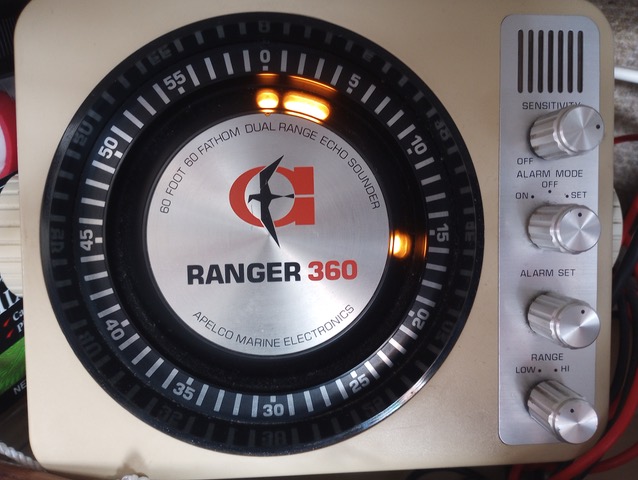
For a pre-internet electronic artifact, a web search came up with nothing. I called Raytheon (I mean Raymarine; no, I mean FLIR), and they had no idea either. “That was too many companies ago,” to paraphrase their response. It seemed that it used to work when I bought the boat, but at some point, it had begun only giving a blur of lights in the 0-5-feet range. I recognized this might have something to do with my messing around in the settee locker and disturbing the transducer over the years.
I suspected the silicone seal holding the transducer was compromised, so I reasoned that it would need at least removal and reinstallment regardless of revival or replacement. An in-hull transducer would not work with air between it and the hull, so I pried it out for inspection. The Raytheon transducer was a rectangle type with a blue face. The blue part had some corrosion, and the resultant expansion had cracked the outer plastic in one corner.
I decided to test the Ranger 360 by holding the transducer directly on the water surface over the side of Sampaguita. It immediately came alive with a reading of 19 feet in my slip. I checked with the lead line … 19 feet. Spot on. I double-checked and triple-checked.
Revival of the Ranger 360 was looking good, but a new transducer was in order. It seemed to work, but the corrosion and crack deemed it replaceable. Interest in drilling a hole in the hull was nil and would require a haulout. I would still use an in-hull transducer, whether a new sounder or a revival of the old. There were many doubters about this approach, including myself, so I needed some confidence that it would reliably shoot through the hull. For this, I used a bag of water. This method is how Airmar tells you to test their transducers when choosing an in-hull placement spot. It read 18 feet from under the settee, one foot below the waterline. Yes!
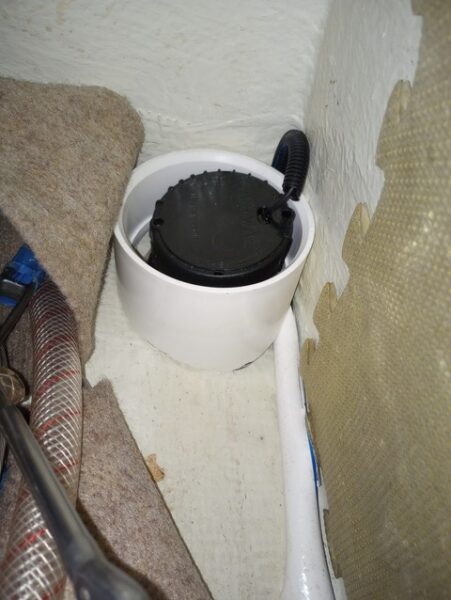
Echo sounding is a simple technology dating back over 100 years. The new units that send and interpret the sonar are fancier and more capable, but the concept is essentially the same. The Airmar P79 seemed an industry standard for in-hull transducers and had been around for decades. OK, but they were still $150 with far more wires than the three I needed for the 1985 Ranger 360. A search on eBay turned up a New Old Stock, three-wire Airmar P79 for $45, including shipping. That was more like it. The transducer had an early-2000s manufacture date, but was unboxed and new.
I followed the installation instructions that came with the new transducer. I found a more suitable and protected spot under the settee and adjusted the transducer and its separate base to the deadrise of the boat. I cleaned the hull well with alcohol but did not do any grinding. Using silicone, I adhered the bottom piece directly to the factory bilge coating at the best orientation. Once it was cured with a watertight seal, I filled it with water and locked the transducer into it. As directed, overfilling and a little cleanup from overflow were necessary to ensure no trapped air. They recommend mineral oil or antifreeze for the liquid, but I can attest that water works fine. Mineral oil doesn’t freeze and break the transducer. Water is easier to clean up.
Since the settee locker is important storage, I felt it necessary to devise a way to protect the transducer from shifting stores. While planning the transducer installation, I found a four-inch PVC pipe coupler that would fit over it. The bottom would need trimming to match the deadrise but would then surround the transducer wedged in the corner and take any pressure from neighboring items.
The transducer came with more than enough cable, but had no plug on the end. The old plug was an option, but its small size was difficult to work with and required a good solder job. This last part was an issue. My solder equipment and skill were subpar, and I have never been able to do a good soldering job. The Ranger 360 unit had a male three-prong plug. I wondered if a blue nylon butt connector might fit over each prong. Sure enough, it was snug on all three prongs. So I crimped connectors onto the transducer wires. “Trial and error” matched each wire to the correct prong, and voila! A working echo sounder.
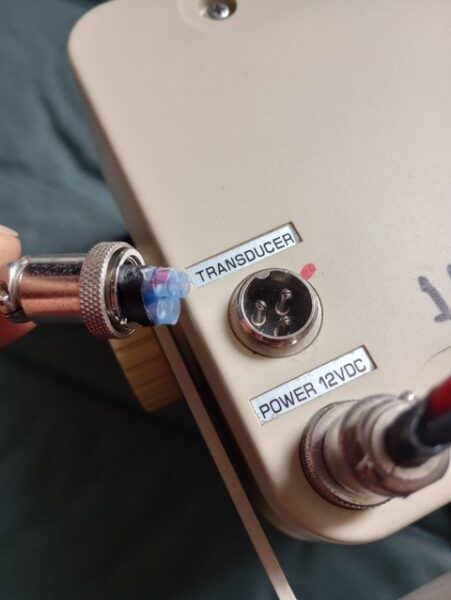
On a 31-day trip around Vancouver Island, it proved itself in 29 anchorages. It helped suss them faster for depth and bottom type. The blur in the 0-5-feet range is still there. I suspect this is distortion caused by the keel and shooting through the hull, but I am not sure. Sampaguita has a draft of one meter, so she has no business in that depth of water anyway. The actual sounding measurement also varies between “crisp” and “blurry.” I understand this represents the bottom type. Crisper is typical of a hard or rockier seabed, and blurrier, a mud or weed bottom. Testing shows it consumes about 0.5 amps, with use a few minutes per day.
The Resourceful Sailor is still cautious, has a lead line, and uses charts and books, but he saw potential in a depthsounder if the value-to-production ratio made sense. Revival of the Ranger 360 Echo Sounder was not just an economical choice; the installation was entirely non-destructive. The unit is easy to read and analog, like Big Ben, and the reason for its size. It was also the one he owned already.
Remember, keep your solutions prudent and safe, and have a blast.
Comment on the Oakland Estuary at BCDC Meeting on Wednesday
Many sailors have expressed their concern over the many problems plaguing the Oakland Estuary. After months and years of neglect, the Estuary is finally attracting the attention of several agencies, such as the BCDC, which has its next scheduled enforcement committee meeting for Wednesday, September 27, from 9:30 a.m. to 12 p.m.
You can email comments, attend via Zoom, attend via teleconference, or even attend in person at the Yerba Buena Room at 375 Beale St. in San Francisco.
Your options are here:
Click here for Zoom. Learn more about public participation here.
To join by teleconference, dial (816) 423-4282. Conference code: 052719, passcode: 123244
Click here for September 27 Enforcement Committee Meeting Materials.
If you would like to comment on an item scheduled for a public hearing, then you may do so by emailing comments one day in advance to [email protected].
Comments provided during the public comment portion of the meeting will be by telephone or via the web. Public speakers participating via web will be asked to raise their hands and speak when called upon.

